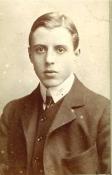
|
The King's School Canterbury |
Roll of Honour |
| Lieutenant Colonel Donald Knox ANDERSON MC | |
|
6th (Service) Battalion East Kent Regiment (the Buffs) attached to the Machine Gun Corps Date of birth: 11th May 1886 Date of death: 3rd December 1917 Killed in action aged 31 Commemorated on the Cambrai Memorial Panel 3 |

|
| He was born at Hollywood, Rochester in Kent on the 11th of May 1886 the second son of George Knox Anderson MP JP, cement manufacturer and Member of Parliament for Canterbury from August to December 1918, and of Mary Ada (nee Pratt) of Bridge Hill House, Bridge near Canterbury. He was educated at the King's School Canterbury from January 1899 to December 1904 during which time he became a member of the school sports committee in 1904, played 1st XI Cricket in 1903 and 1904 and for the Rugby XV in 1904. On the 18th of March 1905 he was commissioned as a 2nd Lieutenant in the 3rd Battalion East Kent Regiment (Militia) and was promoted to Lieutenant on the 28th of April 1906. On the 8th of January 1908 he obtained a regular army commission as a 2nd Lieutenant in the East Kent Regiment and was posted to the 2nd Battalion. He saw service in South Africa, Hong Kong, Singapore and India. On the 28th of November 1914 he was married to Mary Annabella (nee Sandilands) at St Jude's Church, South West London in a quiet ceremony with no guests being invited due to the recent death in action of his brother Colin; they had a son. Following his death she was remarried to Major Hubert Thomas Dempster, Suffolk Regiment at the Church of Our Lady of Victories, Kensington on the 4th of March 1919. In August 1914 he was on home leave from India as a Lieutenant and was appointed to the newly formed 6th (Service) Battalion, serving with them until May 1915. He was promoted to Captain on the 6th of May 1915 and on the 17th of May he was appointed as Brigade Machine Gun Officer. He landed in France on the 1st of June 1915 serving in his new capacity for a year during which time he was mentioned in despatches twice. He went on leave from the 8th to the 17th of April 1916 and was promoted to temporary major while in command of a Machine Gun Company on the 14th of July 1916. He went on leave to England from the 14th to the 24th of September 1916. He was awarded the Military Cross, which was announced in the London Gazette on the 20th of October 1916. The citation read: - "For conspicuous gallantry during operations. For over a fortnight he was in the front line, and did fine work with his guns. His emplacements were repeatedly blown in, and it was largely due to his personal example and courage that his guns were kept in action." He relinquished his temporary rank on the 26th of October 1916 when he was promoted to temporary Lieutenant Colonel and was appointed as Machine Gun Officer to 7th Corps and joined the staff at their headquarters on the 20th of November. He went on leave from the 18th of June to the 5th of July 1917. He was appointed as Machine Gun Officer for 61st Division with the temporary rank of Lieutenant Colonel on the 25th of July 1917. He went on leave from the 3rd to the 18th of November 1917. His wife received the following telegram dated the 8th of December 1917: - "Deeply regret to inform you Lt Col D.K. Anderson M.G.C. was killed in action December third. The Army Council express their sympathy." His Commanding Officer wrote:- "He is a great loss to the Division and to me personally. He was not only a capable and valuable officer, but a companion I was always glad to have, and we all liked and admired him as a man and as a soldier." His brother, Lieutenant Colin Knox Anderson 1st Battalion Queen's Own (Royal West Kent Regiment), was killed in action on the 23rd of August 1914. The Anderson Gift at the King's School was founded in 1918 by George Knox Anderson in his son's name. It is awarded to OKS leavers who join the services. He played cricket for the Band of Brothers and is commemorated on their war memorial as well as on the memorial at Bridge in Kent. He is also commemorated on the memorial at Frindsbury in Kent, on the memorial in the St Stephen's Lobby of the House of Commons and on the memorial at St Mary of Charity Church, Faversham. |
|
Back